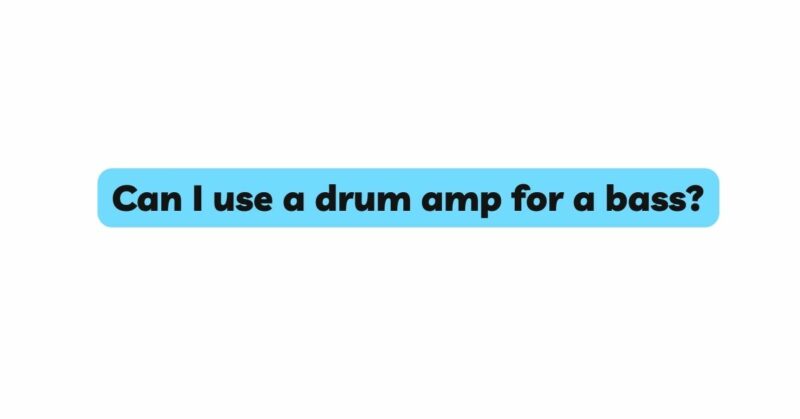In the realm of music, innovation often stems from challenging conventions and pushing the boundaries of traditional approaches. When it comes to amplification, musicians are known to experiment with different setups to achieve unique sonic textures. An intriguing question arises: Can you use a drum amp for a bass guitar? This article embarks on a journey into uncharted soundscapes, delving into the possibilities, challenges, and creative potential of using a drum amplifier to amplify the resonant tones of a bass guitar.
Understanding Drum Amplifiers and Bass Guitars
Before diving into the concept of using a drum amplifier for a bass guitar, it’s essential to grasp the characteristics of both instruments and amplifiers. Drum amplifiers, also referred to as drum monitors, are designed to capture the intricate nuances of percussion instruments, such as drums and cymbals. These amplifiers emphasize clarity, definition, and accurate sound representation to assist drummers during live performances and rehearsals.
Bass guitars, on the other hand, produce deep and resonant low-frequency tones that lay the foundation of the musical arrangement. Bass amplifiers are tailored to reproduce and enhance these low-end frequencies, providing a solid and resonant backbone to the music.
Exploring the Idea of Using a Drum Amp for a Bass Guitar
The idea of using a drum amplifier for a bass guitar is unconventional, yet it opens up a realm of creative possibilities. From a technical standpoint, it is possible to connect a bass guitar to a drum amplifier using appropriate cables and connectors. However, this approach requires careful consideration of various factors, including frequency response, tonal characteristics, and sound quality.
Drum amplifiers are engineered to highlight mid-range frequencies, which can significantly differ from the low-frequency nature of a bass guitar. This distinction in frequency response can impact the overall tonal balance and sound projection when a drum amplifier is used for a bass guitar.
Frequency Response and Tonal Balance
A central challenge of using a drum amplifier for a bass guitar lies in the disparity of frequency response. Bass guitars generate deep and resonant low-frequency tones that demand amplification systems capable of accurately reproducing these frequencies. In contrast, drum amplifiers excel at capturing mid-range frequencies, often leaving the lower and higher ends of the frequency spectrum underrepresented.
This discrepancy can lead to a lack of depth and fullness in the bass tones, potentially resulting in distortion or muddiness. Although equalization adjustments can mitigate some challenges, achieving the ideal tonal balance becomes an intricate process, often requiring a compromise between the amplifier’s inherent characteristics and the desired bass guitar sound.
Sound Projection and Amplifier Power
Another consideration is sound projection and amplifier power. Bass guitar amplifiers are designed to handle the power and dynamics of low-frequency tones, ensuring the bass tones remain clear and punchy even at high volumes. Drum amplifiers, while capable of projecting sound, might not possess the same level of power or efficiency in handling bass frequencies.
Using a drum amplifier for a bass guitar could lead to insufficient sound projection, particularly in scenarios demanding robust and punchy bass tones. The amplifier’s ability to accurately reproduce the low-end frequencies of a bass guitar is essential for maintaining the integrity of the musical arrangement.
Tonal Adaptations and Equalization
To maximize the use of a drum amplifier for a bass guitar, adaptations and equalization adjustments are crucial. Experimenting with the amplifier’s tone controls, such as bass, mid, and treble settings, can help tailor the sound to better match the characteristics of the bass guitar.
However, it’s essential to recognize that equalization adjustments might only address part of the challenge. While certain tonal improvements can be achieved, the drum amplifier might not fully deliver the depth and resonance of a dedicated bass amplifier.
Creative Exploration and Sonic Innovation
Amidst the challenges and limitations, using a drum amplifier for a bass guitar offers a space for creative exploration and sonic innovation. Some musicians actively seek unconventional sound textures that challenge traditional norms. In such cases, the tonal qualities of a drum amplifier can introduce a unique sonic dimension to the bass guitar’s sound, contributing to a distinctive and unexpected sonic identity.
Musicians embracing this approach should approach it with an open mindset, ready to welcome the serendipitous tonal qualities that emerge from combining two different types of amplification systems.
Conclusion
In conclusion, while it is technically possible to use a drum amplifier for a bass guitar, there are significant challenges and considerations to navigate. Drum amplifiers are tailored to capture mid-range frequencies, potentially leading to imbalances and distortion when amplifying the low-frequency tones of a bass guitar. The differences in frequency response, tonal balance, and sound projection can present obstacles that require careful adjustments.
Using a drum amplifier for a bass guitar might be most suitable for musicians seeking unconventional sonic landscapes and experimental textures. However, for situations that demand clear, powerful, and resonant bass tones, investing in a dedicated bass amplifier remains the more practical choice.
Ultimately, the decision to use a drum amplifier for a bass guitar should be guided by artistic vision, musical context, and the desire to push the boundaries of sound exploration. As musicians continue to innovate, the exploration of unconventional amplification methods adds an intriguing layer of creativity to the evolving world of music.

